Top Conversion Tracking Tools to Boost Your ROI in 2025
Top Conversion Tracking Tools to Boost Your ROI in 2025
Unlocking Marketing Success: The Power of Conversion Tracking
Want to know which marketing campaigns are driving leads and sales? Stop guessing. This list of top 10 conversion tracking tools reveals how to pinpoint your best lead sources, optimize your campaigns, and boost your ROI. Discover which platforms—from simple integrations to robust analytics suites—perfectly match your needs, whether you're using landing pages and forms or running complex multi-channel campaigns. We cover leading conversion tracking tools like Google Analytics 4, Meta Pixel, HubSpot, and more, so you can finally understand where your customers are coming from.
1. LeadPulse
Are you a non-technical marketer struggling to understand where your leads are coming from? Tired of incomplete UTM data in your CRM? LeadPulse is a conversion tracking tool designed specifically for you. It offers a simple way to gain clear visibility into your lead attribution, going beyond just paid campaigns and UTM parameters, to provide a holistic view of your marketing performance. This allows you to confidently optimize your marketing spend and improve ROI by understanding which channels are truly driving results.
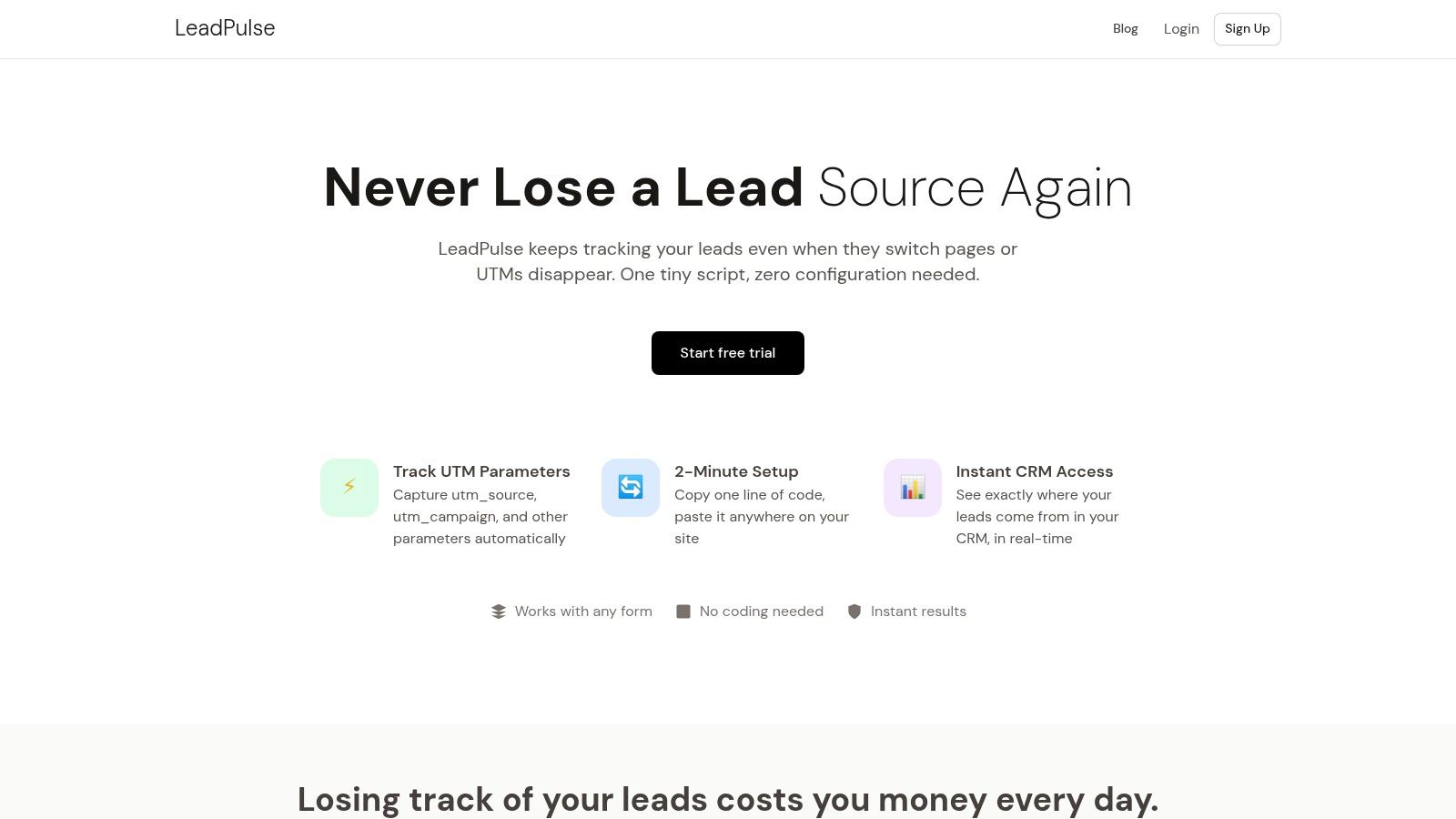
Unlike complex analytics platforms that often lose track of lead sources or provide confusing reports, LeadPulse maintains accurate tracking across multiple pages and channels. Whether a lead comes from Organic Search, Social Media, Referral links, or Direct traffic, LeadPulse captures the data and seamlessly pushes it into your CRM. This includes popular platforms like HubSpot, Salesforce, Airtable, and Pipedrive, allowing you to see the complete lead journey directly within your sales tools. This eliminates the need for manual data entry and provides real-time insights into lead sources.
For those familiar with the frustration of missing UTM parameters, LeadPulse offers a unique advantage. It captures full attribution data even when UTMs are lost, maintaining accuracy across multiple pages. Furthermore, its upcoming AI-powered fallback attribution feature promises to intelligently detect lead sources even when UTMs are missing entirely.
Implementing LeadPulse is incredibly simple. With an effortless 2-minute setup involving a single line of script and no coding required, even the most technically challenged marketers can get started quickly. This “set it and forget it” approach to conversion tracking frees up valuable time to focus on other marketing activities.
Pricing and Technical Requirements:
LeadPulse offers flexible pricing plans, including a free tier for up to 10 leads per month. This makes it accessible for small businesses and startups just starting with conversion tracking. Premium subscription tiers are available for larger businesses requiring higher lead volumes. They also offer early bird lifetime deals and priority support options. The only technical requirement is the ability to add a single line of JavaScript to your website.
Pros:
- Effortless 2-minute setup with a single script and no coding.
- Captures full attribution data even without UTM parameters.
- Seamless integration with 15+ popular CRMs.
- AI-powered fallback attribution (coming soon).
- Flexible pricing plans, including a free tier.
Cons:
- Advanced AI-powered attribution and multi-domain support are not yet available.
- The free plan is limited to 10 leads per month.
Why LeadPulse Deserves its Place on this List:
LeadPulse earns its spot as a top conversion tracking tool due to its simplicity, comprehensive tracking capabilities, and seamless CRM integrations. It’s specifically designed for non-technical users who want a hassle-free way to understand their lead attribution and improve their marketing ROI. Its focus on ease of use and affordability makes it a valuable asset for small businesses, startups, and marketing agencies alike.
Website: https://getleadpulse.com
2. Google Analytics 4
Google Analytics 4 (GA4) is the latest version of Google's powerful analytics platform and a must-have conversion tracking tool for businesses of all sizes. It helps you understand website and app performance, user behavior, and, crucially for lead generation, your conversion metrics. Unlike its predecessor, Universal Analytics, GA4 uses an event-based data model, allowing for more flexible and detailed tracking across various platforms. This means you can see the complete customer journey, from the first website visit to form submission, even if they switch between devices. For marketers focused on lead generation, this provides invaluable insights into which marketing efforts are driving the most valuable conversions.
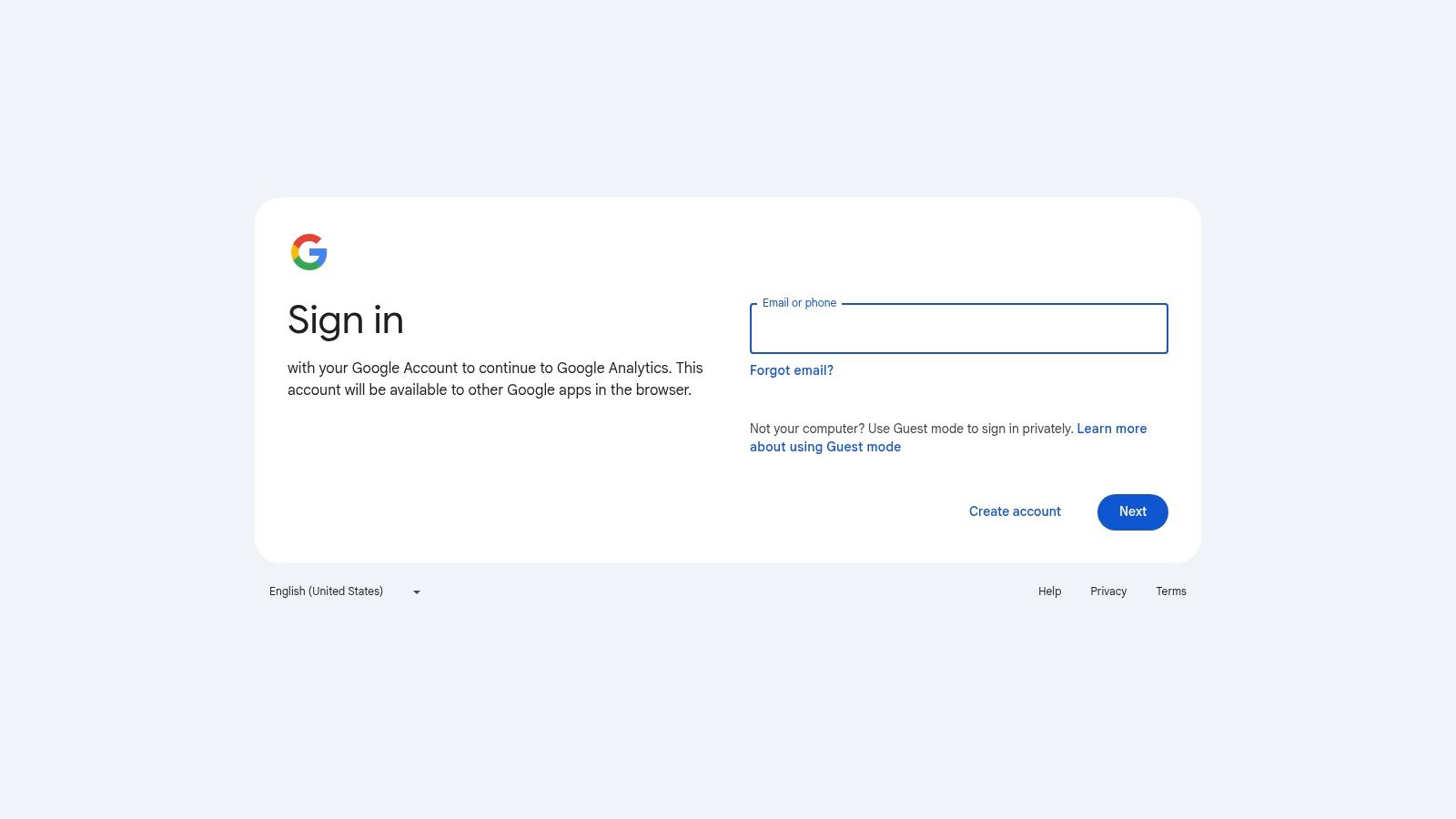
GA4's strength lies in its comprehensive approach to conversion tracking. You can set up custom conversion events for actions like form submissions, button clicks, or even video views, allowing you to track precisely what matters most to your business. This granular level of tracking makes it significantly easier to understand what content and campaigns resonate with your audience and ultimately drive leads. Its machine learning capabilities further enhance its value by providing predictive insights and identifying potential customers, allowing you to optimize your marketing strategies proactively. For businesses using forms and CRMs, GA4's ability to integrate with other Google products, such as Google Ads, provides a seamless experience for tracking ad campaign effectiveness and ROI. Learn more about Google Analytics 4 for insights on maximizing your attribution strategy.
Features:
- Event-based tracking: Track virtually any interaction on your website or app as a conversion.
- Cross-platform tracking: Follow users across devices and platforms for a holistic view of their journey.
- Machine learning: Leverage AI for predictive analytics and audience insights.
- Enhanced e-commerce tracking: Analyze purchase funnels and optimize your sales process.
- Google Ads integration: Streamline campaign tracking and improve ad performance.
Pros:
- Free: GA4 is free to use for most businesses.
- Comprehensive: Collects a wide range of data for in-depth analysis.
- Powerful integrations: Works seamlessly with other Google marketing tools.
- AI-powered insights: Gain predictive insights to optimize your campaigns.
Cons:
- Learning curve: Can be initially challenging for users unfamiliar with the platform.
- Limited historical data: Migrating data from older versions can be complex.
- Privacy restrictions: Be mindful of evolving data privacy regulations that may impact tracking capabilities.
Implementation Tips:
- Set up custom conversion events: Define the specific actions you want to track as conversions, like form submissions.
- Link to Google Ads: Integrate with your Google Ads account to gain deeper insights into your ad campaign performance.
- Explore the reports: Familiarize yourself with the various reports available in GA4 to understand user behavior and conversion patterns.
GA4 deserves a prominent place in this list of conversion tracking tools because it provides a powerful, free, and comprehensive solution for businesses looking to understand and optimize their marketing efforts. While there's a learning curve, its flexible event-based tracking, cross-platform capabilities, and advanced machine learning make it a worthwhile investment for any marketer, especially those focused on lead generation through forms and CRMs. Its seamless integration with other Google products further solidifies its position as a leading conversion tracking tool. You can access GA4 and create your account at https://analytics.google.com/.
3. Meta Pixel (Facebook Pixel)
The Meta Pixel (formerly Facebook Pixel) is a powerful conversion tracking tool specifically designed for businesses advertising on Facebook and Instagram. It's a snippet of code that you place on your website to track visitor activity and understand how effective your ads are. This data helps you optimize your ad targeting, retarget website visitors who showed interest but didn't convert, and measure conversions across different devices. For businesses deeply invested in the Meta ecosystem, it's an essential tool for understanding campaign performance and maximizing ROI. This free tool offers a comprehensive suite of features for tracking and optimizing your advertising efforts. It’s especially useful for the non-technical marketer who relies on Meta ads to drive leads and sales.
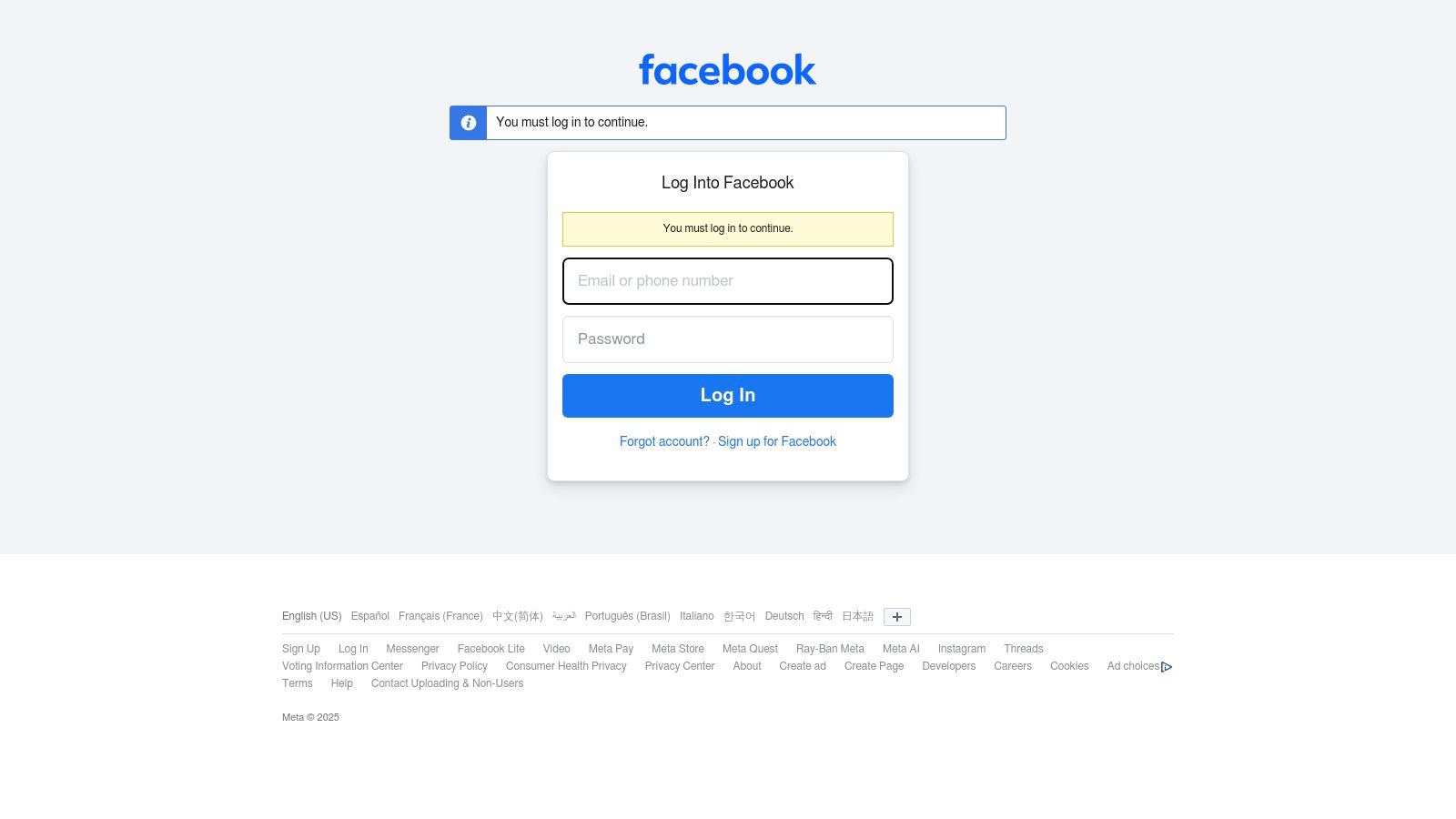
For example, imagine you're a consultant running a Facebook ad campaign to promote a free webinar. The Meta Pixel can track how many people who clicked your ad actually signed up for the webinar. This allows you to see which ads are performing best and adjust your campaign accordingly. It can also track actions beyond initial sign-ups, such as if registrants attended the webinar and subsequently purchased your services. This full-funnel tracking enables a comprehensive understanding of your campaign's impact. Furthermore, the pixel facilitates retargeting; you can show specific ads to people who visited your webinar registration page but didn't complete the sign-up, reminding them of the upcoming event and potentially converting them into attendees.
Key Features:
- Conversion API for Server-Side Tracking: This complements the browser pixel, mitigating data loss due to browser restrictions and offering more reliable tracking.
- Custom Audience Creation: Build targeted audiences based on specific website activity like product views, adding items to a cart, or completing a purchase. This allows you to tailor your ads to users who have demonstrated interest in your offerings.
- Standard and Custom Conversion Event Tracking: Track standard events like purchases and leads, or define custom events relevant to your business, like webinar registrations or content downloads.
- Automated Event Recognition with Advanced Matching: Meta Pixel can automatically track certain events, minimizing manual setup. Advanced matching helps connect offline conversions with online ad interactions.
- Dynamic Ads Optimization: Show personalized product ads to users based on their browsing history and past interactions with your website.
Pros:
- Seamless Integration with Meta's Advertising Platforms: Direct integration simplifies campaign management and reporting within the Facebook Ads Manager interface.
- Robust Remarketing Capabilities: Target users who have already interacted with your website or shown interest in specific products or services, boosting conversion rates.
- Real-Time Conversion Reporting and Optimization: Monitor campaign performance in real-time and make data-driven adjustments to improve ROI.
- Free to Use: Implementation is free, regardless of your ad spend, making it accessible to businesses of all sizes.
Cons:
- Impact of Browser Privacy Restrictions and iOS Limitations: Increasing browser privacy features and Apple's App Tracking Transparency framework can limit the data the Pixel can collect.
- Limited Use Outside Meta Platforms: The Pixel primarily benefits businesses advertising on Facebook and Instagram. Its value is diminished if you're not leveraging these platforms.
- Technical Implementation for Optimal Performance: While basic setup is relatively simple, maximizing the Pixel's potential requires some technical expertise, particularly for server-side tracking and custom events.
- Privacy Concerns: Some users find the tracking invasive, which can lead to negative perceptions of your brand.
Website: https://www.facebook.com/business/tools/meta-pixel
Implementation Tip: For non-technical users, several plugins and integrations simplify Meta Pixel installation on platforms like WordPress and Webflow. Look for solutions that offer easy setup without requiring coding knowledge. This allows you to quickly start tracking conversions and gain valuable insights into your ad campaigns.
4. Adobe Analytics
Adobe Analytics is a powerful conversion tracking tool, best suited for large enterprises seeking deep insights into their customer journeys. It goes beyond simply telling you what conversions occurred, and dives into how and why they happened. This enterprise-grade solution offers comprehensive analysis and robust features to optimize your marketing efforts. If you're managing a complex digital ecosystem across multiple channels and need granular data for strategic decision-making, Adobe Analytics can be a valuable asset.
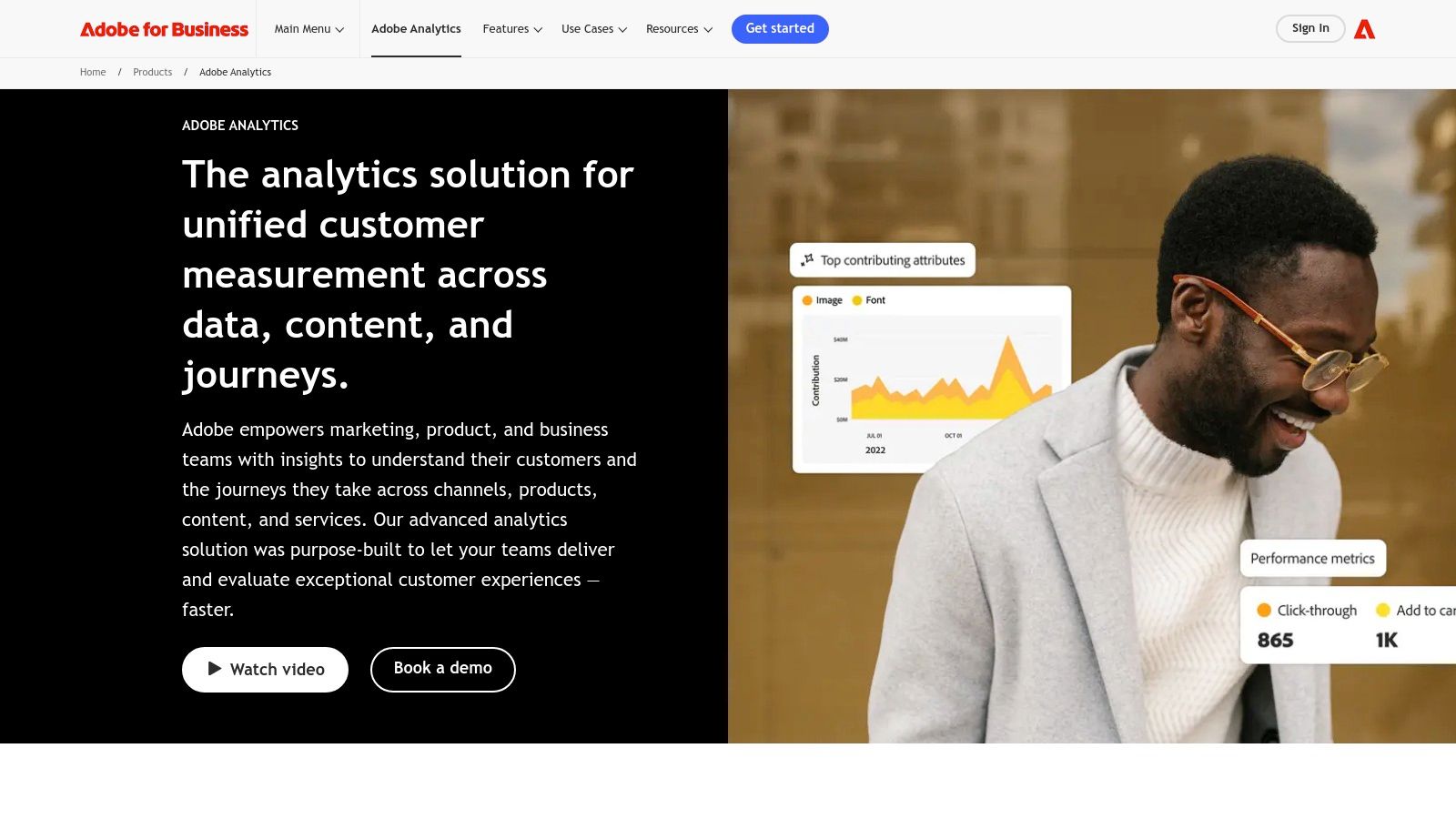
While extremely powerful, Adobe Analytics might be overkill for smaller businesses or individual marketers primarily focused on basic form submissions and lead capture from a limited number of sources. Solutions like Google Analytics or simpler conversion tracking tools within your CRM might suffice for less complex needs. However, if you need advanced segmentation, predictive analytics, and the ability to stitch together the entire customer journey across various touchpoints, Adobe Analytics stands out.
Key Features and Benefits for Conversion Tracking:
- Advanced Customer Journey Analysis: Map the complete customer journey across all touchpoints—from initial website visit to final conversion—to identify bottlenecks and optimization opportunities. This is particularly beneficial for understanding complex sales funnels.
- Robust Segmentation: Slice and dice your audience based on a wide range of criteria (demographics, behavior, acquisition source, etc.) to understand how different customer segments convert. This helps tailor marketing campaigns for maximum effectiveness.
- Custom Conversion Metrics: Define and track specific conversion metrics relevant to your business, going beyond standard metrics like form submissions. This allows you to track micro-conversions and other key performance indicators (KPIs) aligned with your business goals.
- Predictive Analytics: Anticipate future trends and identify potential issues through anomaly detection. This proactive approach allows you to optimize campaigns and address potential problems before they significantly impact conversions.
Pros:
- Enterprise-level Capabilities: Comprehensive features and scalability ideal for complex organizations with high data volumes.
- Deep Customization: Tailor the platform to specific business needs and integrate with existing marketing technology stacks.
- Extensive Integrations: Connects seamlessly with other Adobe Experience Cloud products and various third-party tools.
- Superior Data Visualization: Create compelling and insightful reports to understand conversion trends and patterns.
Cons:
- High Cost: Adobe Analytics carries a significantly higher price tag than many other conversion tracking tools, making it less accessible to smaller businesses.
- Complex Implementation: Requires specialized technical expertise to set up and configure correctly. This can be a barrier for non-technical users.
- Steep Learning Curve: The platform's extensive features and functionalities can be overwhelming for new users and require dedicated training to master.
Implementation Tips:
- Clearly Define Your Goals: Before implementing Adobe Analytics, identify the specific conversion metrics and KPIs you want to track.
- Plan Your Implementation Strategy: Work with Adobe or a certified partner to develop a comprehensive implementation plan tailored to your business needs.
- Invest in Training: Ensure your team has the necessary training to effectively use the platform and leverage its advanced capabilities.
Website: https://business.adobe.com/products/analytics/adobe-analytics.html
While not the right solution for everyone, Adobe Analytics offers unmatched power for enterprise-level conversion tracking and analysis. If you need deep insights into your customer journey and the resources to invest in a robust platform, Adobe Analytics can provide the tools you need to optimize your conversions and drive business growth.
5. Mixpanel
Mixpanel is a powerful conversion tracking tool specifically designed to help you understand how users interact with your digital products and apps. Unlike tools focused on broad marketing campaigns, Mixpanel excels at diving deep into user behavior within your product. This makes it an excellent choice for product teams and businesses focused on optimizing user experiences and identifying conversion opportunities within their app or website. For those focused on optimizing the user journey from signup to purchase, or understanding how users engage with specific features, Mixpanel provides valuable insights. Are users dropping off at a certain point in your onboarding flow? Mixpanel can help pinpoint the problem. Want to know which features lead to higher conversion rates? Mixpanel can illuminate those pathways. This granular, user-centric approach to conversion tracking makes it a valuable asset for improving your product and ultimately, driving business growth.
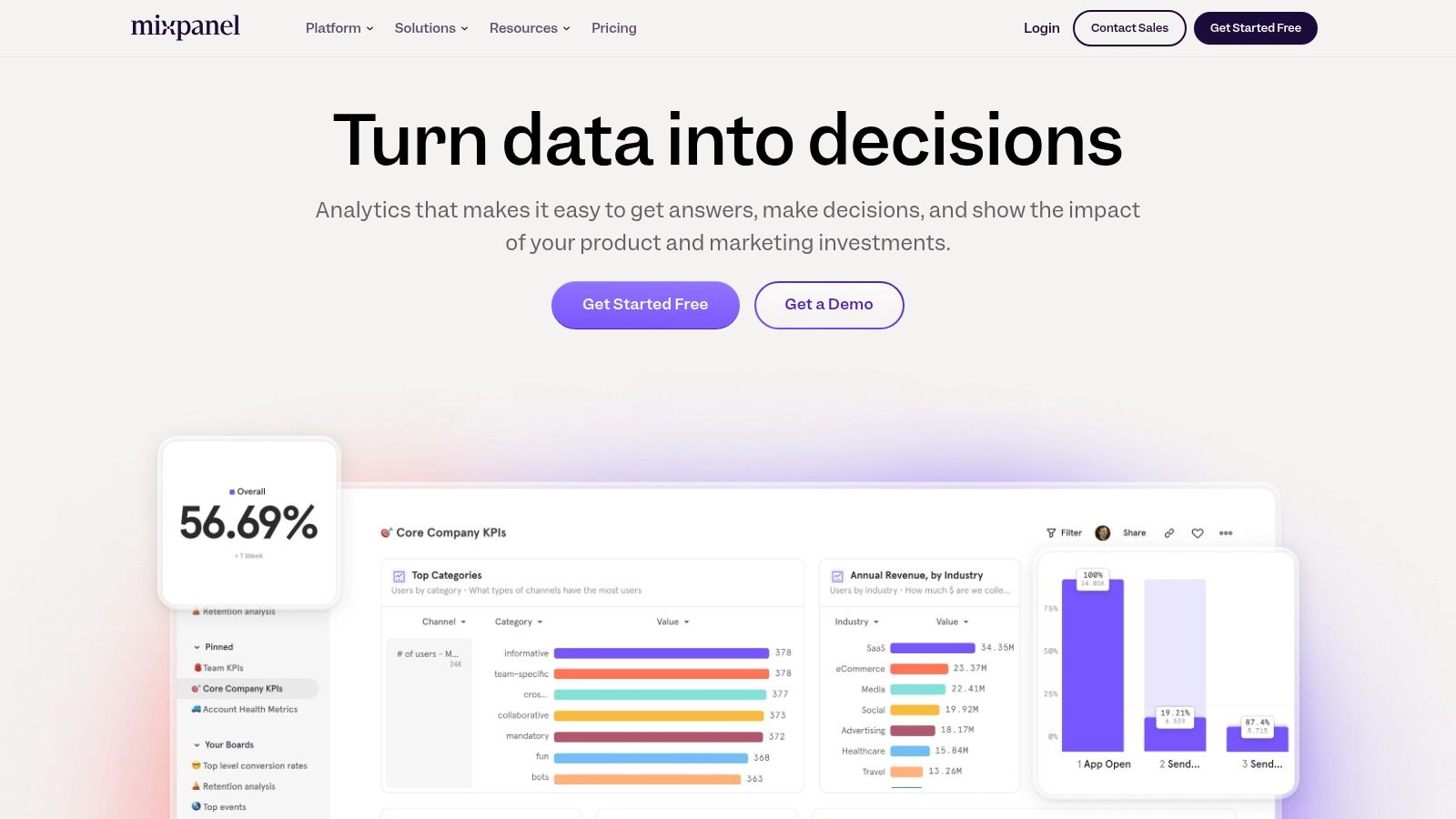
Mixpanel's key features include user-centric event tracking and conversion funnels, cohort analysis for measuring user retention, and A/B testing capabilities for optimizing conversion rates. You can track custom events tailored to your specific needs, allowing you to analyze exactly how users are interacting with particular features. Real-time data analysis and reporting features provide immediate feedback, allowing you to react quickly to changing user behavior. For those concerned with measuring the effectiveness of marketing campaigns aimed at boosting in-app actions, Mixpanel can bridge the gap between marketing efforts and product engagement, showing you how those campaigns are impacting key in-product metrics. You can also learn more about Mixpanel and how to measure your marketing campaign success in general.
Pros:
- Excellent for product and mobile app conversion tracking: Perfect for analyzing in-app events and user flows.
- Intuitive interface for analyzing user journeys: Easy to visualize and understand user behavior.
- Strong visualization tools for conversion funnels: Clearly see where users are dropping off in your conversion process.
- Free tier available for small businesses or products: Allows you to get started and explore the platform without a large initial investment.
Cons:
- Can become expensive as tracking volume increases: Pricing scales with usage, so it can become costly for high-traffic applications.
- More focused on product analytics than marketing campaign tracking: While you can track some marketing efforts, it's primarily designed for product analysis. Less suited for non-technical marketers looking to understand multi-channel attribution.
- Requires proper event planning and implementation: Getting the most out of Mixpanel requires upfront planning to define and implement relevant events.
- Less comprehensive for multi-channel marketing attribution: If you're focused on understanding the full customer journey across multiple marketing channels, other tools might be more suitable.
While Mixpanel might require some initial setup to define the specific events you want to track, the insights it provides into user behavior and product performance make it a worthwhile investment for many businesses. If you're a SaaS founder, run a B2B startup, or manage a mobile app, Mixpanel can be a valuable addition to your conversion tracking toolkit, providing the deep product-focused insights you need to optimize user experience and boost conversions. Visit the Mixpanel website to learn more and explore their pricing options.
6. HubSpot
HubSpot is more than just a conversion tracking tool; it's a comprehensive marketing, sales, and service platform that includes powerful conversion tracking features. This makes it particularly useful for businesses who want to connect their marketing efforts directly to sales outcomes, providing a clear picture of ROI. Think of it as a central hub for all your customer interactions, tracking leads from their initial website visit all the way through to becoming a paying customer. This is especially beneficial for B2B companies with longer sales cycles where understanding the customer journey and attributing conversions to specific touchpoints is crucial.
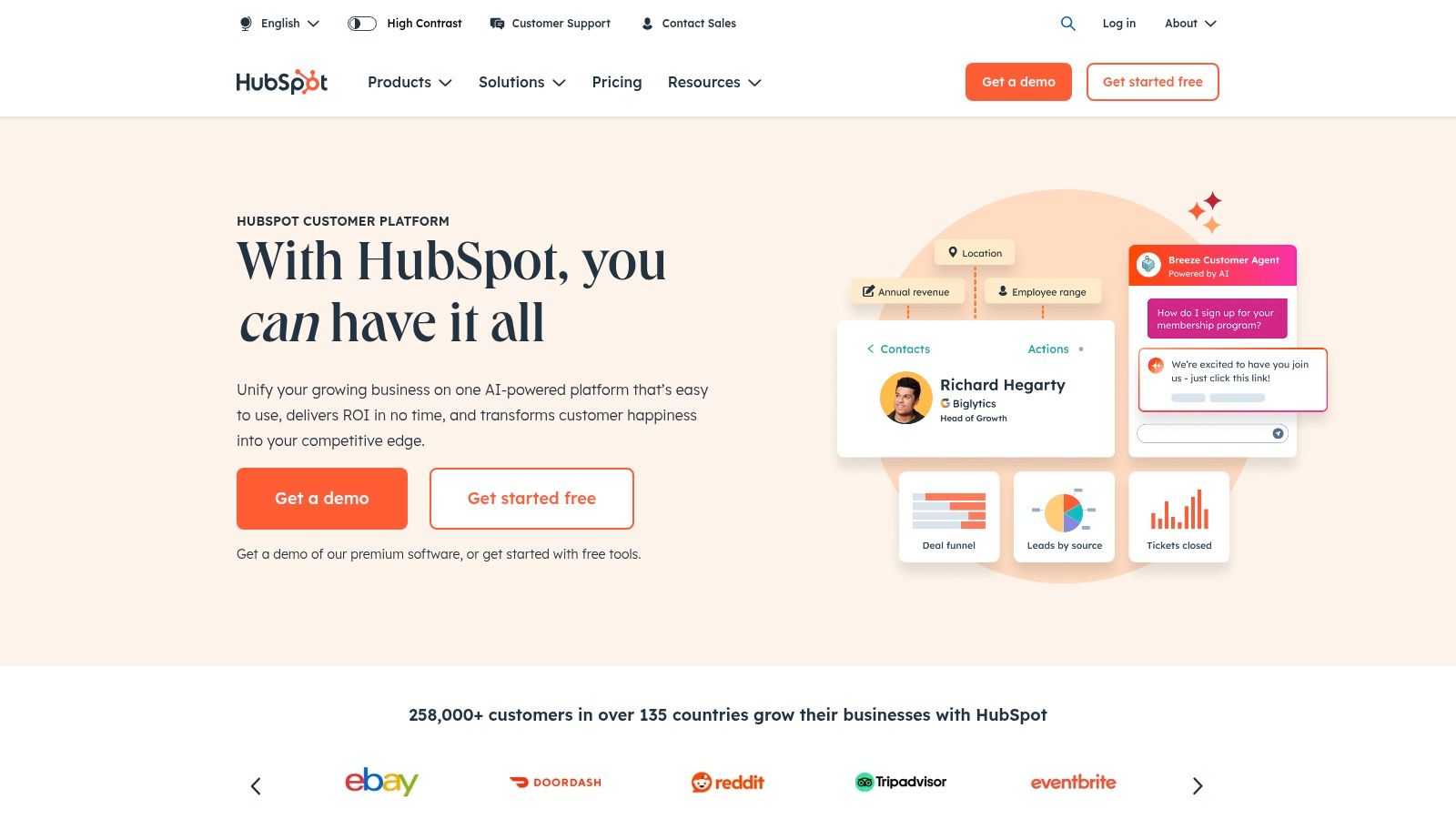
For non-technical marketers and small business owners using tools like WordPress, Typeform, and Gravity Forms, HubSpot offers an intuitive way to see which marketing activities are generating leads and customers. Imagine easily tracking which blog post, social media campaign, or paid advertisement led a specific customer to fill out a form on your website. HubSpot simplifies this complex process. You can finally connect the dots between your marketing investments and your sales pipeline without needing to grapple with complex code or analytics dashboards. For those pushing leads into CRMs like Salesforce, Airtable, or Pipedrive, HubSpot integrates seamlessly, ensuring that all your lead data is in one place and readily accessible. This “set and forget” tracking is ideal for busy entrepreneurs and marketers who want a streamlined solution.
HubSpot excels at providing a visual representation of the entire customer journey, allowing you to see exactly how leads interact with your brand across different channels. This all-in-one platform handles everything from initial website visits and form submissions to email opens, clicks, and ultimately, closed deals. Features like lead scoring and attribution modeling help you prioritize high-potential leads and understand which marketing efforts are most effective. You can analyze form submissions, track calls-to-action (CTA) click-through rates, and delve deep into your email marketing performance to see what’s resonating with your audience and driving conversions.
Features:
- End-to-end conversion tracking from marketing to sales
- Lead scoring and attribution modeling
- Form submission and CTA conversion tracking
- Email marketing performance and conversion analysis
- Integration with CRM for closed-loop reporting
Pros:
- All-in-one platform connecting marketing to sales outcomes
- Intuitive interface accessible to non-technical users
- Excellent visualization of the complete customer journey
- Free starter tier for basic conversion tracking
Cons:
- Higher pricing tiers required for advanced features
- Less granular data compared to dedicated analytics tools like Google Analytics
- Most valuable when using the entire HubSpot ecosystem. While it can be used standalone, its full potential is unlocked within the broader HubSpot suite.
- Can be overkill for very simple conversion tracking needs
Pricing: HubSpot offers a free CRM and starter tier for basic conversion tracking. Paid plans with more advanced features start at a higher price point, scaling with the size and needs of your business.
Website: https://www.hubspot.com/
HubSpot earns its spot on this list because it bridges the gap between marketing activities and sales results. Its comprehensive platform, intuitive interface, and powerful features make it a valuable conversion tracking tool, especially for businesses focused on lead generation and nurturing within a robust CRM environment. While it may not be the ideal choice for everyone, particularly those with very simple needs or requiring highly granular data analysis, HubSpot’s comprehensive approach makes it an excellent option for businesses seeking a holistic view of the customer journey and a powerful tool to drive revenue growth. If you’re looking for a user-friendly, all-in-one platform to manage and analyze your conversion tracking efforts, HubSpot is definitely worth exploring.
7. Segment
Segment is more than just a conversion tracking tool; it's a powerful customer data platform (CDP) that acts as a central hub for all your customer data. It collects, cleans, and then distributes that data to various other marketing, analytics, and data storage tools you might be using. Think of it as a universal translator for your customer data, ensuring consistent tracking across all platforms. This makes it incredibly valuable for businesses wanting a unified view of their customer journey without managing a complex web of individual tracking implementations. Instead of setting up separate tracking for each tool, you implement Segment once and let it handle distributing the data. This is particularly helpful for non-technical marketers who are looking for streamlined solutions.
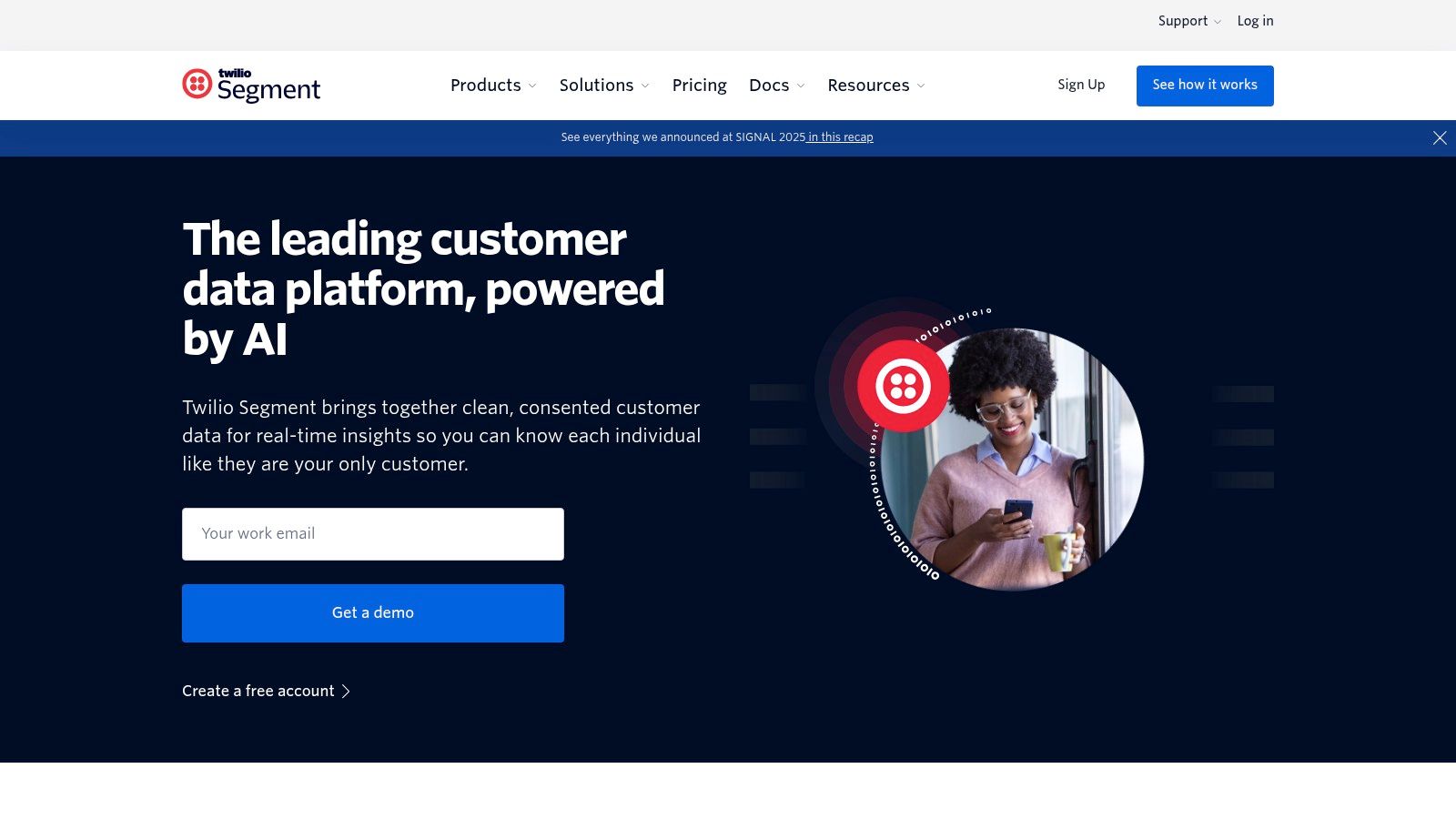
For example, imagine you're using Google Analytics for website analytics, Salesforce for your CRM, and Mailchimp for email marketing. With Segment, you can track a conversion event, like a form submission, once and have that data automatically sent to all three platforms. This eliminates inconsistencies between your tools and gives you a holistic understanding of how your marketing efforts are impacting conversions. Learn more about Segment and how it facilitates accurate lead source tracking. This centralized approach is especially beneficial for those who use multiple platforms like Webflow, WordPress, Typeform, or Gravity Forms and push leads into systems like HubSpot, Salesforce, Airtable, or Pipedrive.
Segment's features include data collection from various sources like websites, mobile apps, and servers. It boasts robust identity resolution for cross-device tracking, meaning you can follow a customer's journey even if they switch from their phone to their laptop. Additionally, its data transformation and filtering capabilities allow you to customize the data sent to each destination platform. This ensures each tool receives the specific information it needs. Real-time event streaming and batch processing further enhance its flexibility, catering to various data needs.
Pros:
- Centralized Implementation: Reduces tracking code bloat on your website, leading to faster load times and a cleaner setup. This simplified “set and forget” tracking is ideal for non-technical users.
- Consistent Data: Ensures conversion data is uniform across all your platforms, providing a single source of truth.
- Flexible Architecture: Easily adapts to changing tech stacks and evolving business needs.
Cons:
- Technical Expertise: Requires some technical understanding for initial setup and configuration, though the ongoing management is simplified.
- Cost: Can become expensive as your data volume grows.
- Reliance on other tools: While Segment collects and routes data, you still need other tools for in-depth analysis and visualization.
- Potentially Overkill: For very simple tracking needs, a dedicated conversion tracking tool might be sufficient.
While pricing details aren't readily available on the Segment website, they offer various plans based on data volume and usage. You can contact their sales team for a customized quote. If you’re a small business owner or marketer primarily focused on lead generation through forms and prefer a one-time setup, Segment's robust capabilities and centralized approach might justify the investment, particularly if you anticipate significant growth and the need for advanced tracking in the future. You can explore more on their website: https://segment.com/.
8. Hotjar
Hotjar isn't your typical conversion tracking tool. Instead of focusing solely on quantitative data like clicks and conversions, Hotjar dives into the why behind user behavior. It combines analytics with feedback tools to give you a comprehensive understanding of what's working, what's not, and why users are abandoning your conversion funnels. This makes it especially valuable for non-technical marketers and small business owners who want a clear picture of their customer journey.
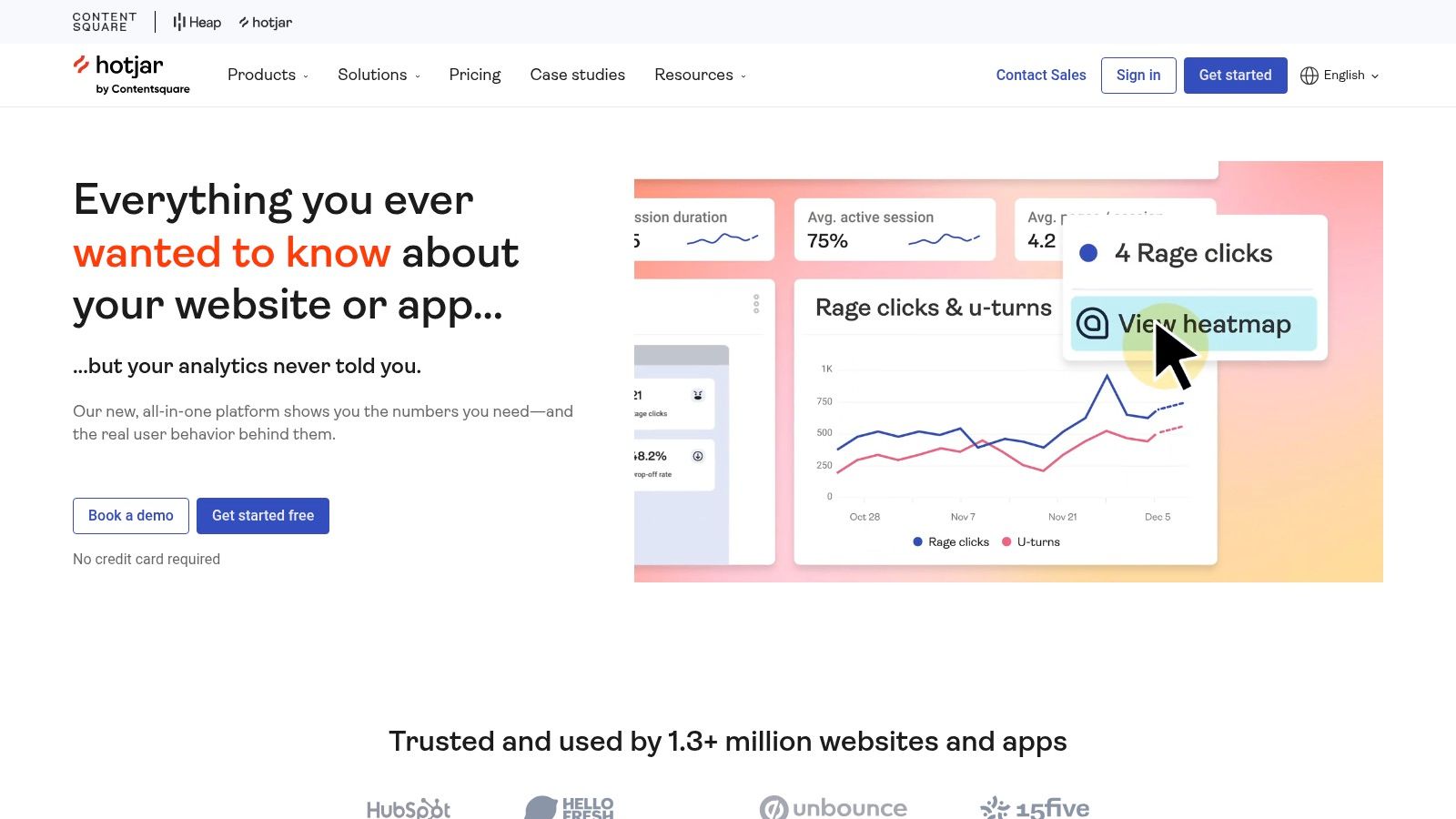
Imagine you're running a lead generation campaign through a landing page with a form, a common scenario for the target audience. You notice a high drop-off rate, but your standard conversion tracking tools only tell you that people are leaving, not why. Hotjar fills this gap. Using heatmaps, you can visualize where users are clicking, moving their mouse, and scrolling, revealing potential points of friction. Session recordings let you watch actual user interactions with your form, showing you where they hesitate, get confused, or abandon the process altogether. On-site surveys allow you to ask users directly about their experience and identify specific obstacles to conversion.
For example, if your heatmaps show low engagement with a particular form field or button, you can hypothesize that users are struggling with it. Confirming this hypothesis is easy with session recordings. Watching a few recordings might reveal that users are repeatedly clicking on a non-clickable element or having trouble understanding the instructions for a particular field. This insight allows you to make informed changes to your form, improving user experience and ultimately boosting conversions.
Hotjar also visualizes conversion funnels, pinpointing exact drop-off points and allowing you to focus your optimization efforts. Its form analysis feature dives deep into individual form fields, identifying areas where users struggle or abandon the process. This is crucial for users of platforms like Typeform and Gravity Forms, ensuring seamless lead capture and integration with CRMs like HubSpot, Salesforce, or Pipedrive.
Features:
- Heatmaps: Visualize click, move, and scroll patterns on your pages.
- Session Recordings: Watch recordings of real user sessions.
- Conversion Funnels: Identify drop-off points in your conversion process.
- On-site Surveys: Collect direct feedback from users.
- Form Analysis: Pinpoint friction in your conversion forms.
Pros:
- Visual insights: Understand the why behind your conversion metrics.
- Easy implementation: Minimal technical knowledge required.
- Combines quantitative and qualitative data: Get a complete picture of user behavior.
- Free plan available: Perfect for smaller websites and initial testing.
Cons:
- Not a complete conversion tracking solution: Best used in conjunction with other tools.
- Sample-based recording: May not capture every user session.
- Limited advanced segmentation: Filtering and segmenting data can be basic.
- Pricing scales with traffic: Costs can increase significantly with higher traffic volumes.
Pricing: Hotjar offers a free basic plan. Paid plans start at $32/month and scale based on the number of pageviews you need to track.
Website: https://www.hotjar.com/
Hotjar earns its place on this list by bridging the gap between quantitative conversion data and qualitative user insights. It's a powerful tool for anyone working with forms and CRMs, seeking to optimize their conversion funnels and understand the "why" behind user behavior, particularly for those who prefer a less technical, "set and forget" approach after initial setup.
9. Heap
Tired of constantly tweaking your conversion tracking and wondering if you're missing crucial data? Heap might be the answer. This powerful analytics platform automatically captures all user interactions on your website – clicks, form submissions, page views, you name it – without requiring you to set up individual tracking events. This "set it and forget it" approach is a game-changer for non-technical marketers who want a comprehensive view of user behavior without the hassle of manual tagging or relying on developers. This autocapture functionality makes Heap a valuable conversion tracking tool, particularly for unearthing unexpected user journeys and optimizing for conversions without complex setup.
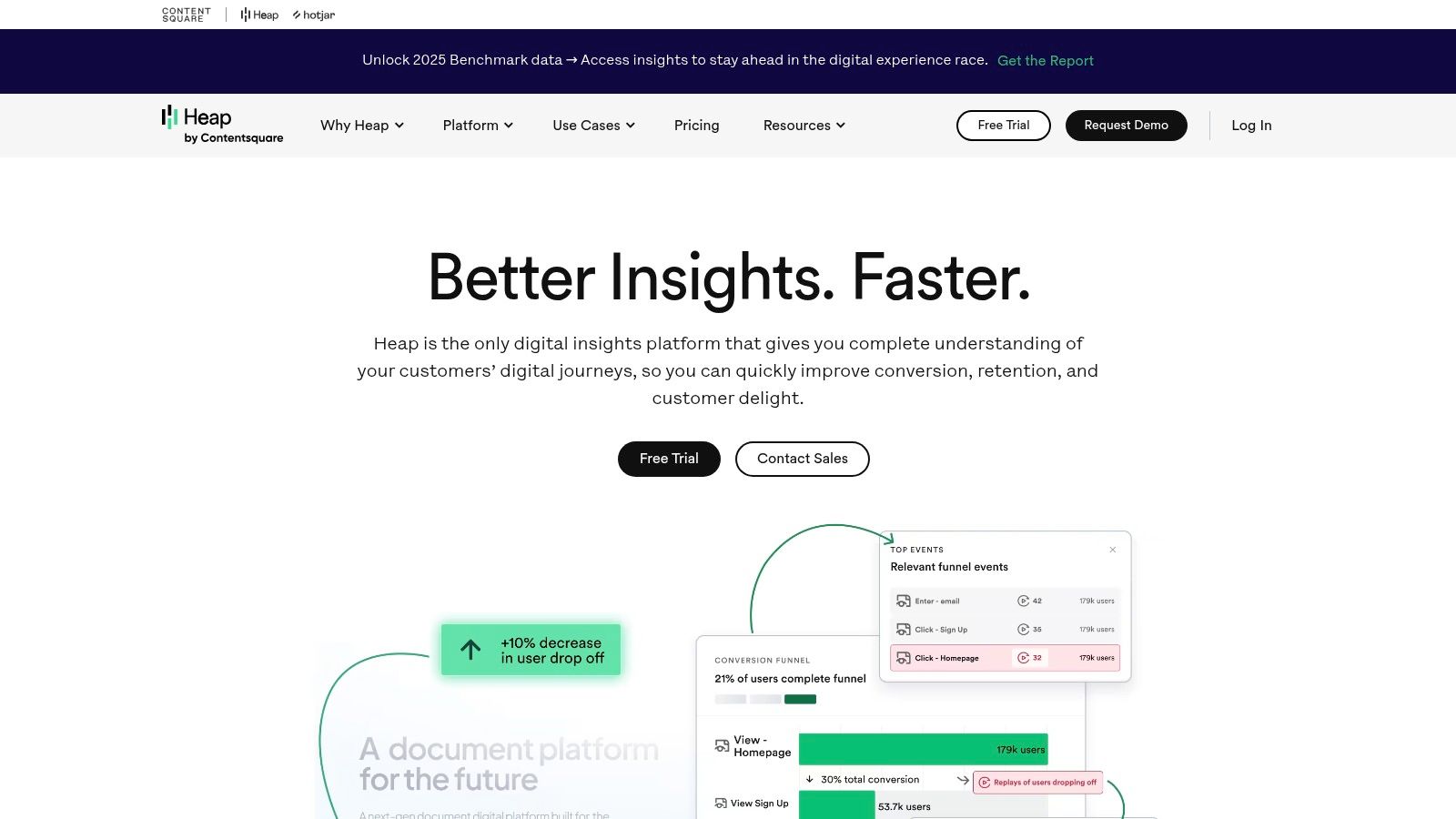
For example, imagine you're running a lead generation campaign with a landing page and a contact form. Instead of pre-defining what you think is important to track, Heap captures everything. Later, you can retroactively define your conversion event – say, a successful form submission – and analyze all the paths users took to get there. Did they click on a specific call-to-action button? Did they visit your pricing page first? Heap provides these insights without requiring you to predict every possible user action beforehand. This is incredibly valuable for identifying unexpected bottlenecks and optimizing your conversion funnel. Furthermore, Heap's session replay feature allows you to watch actual user sessions, providing qualitative insights into how people interact with your website. You can see exactly where they hesitate, get confused, or abandon the process, giving you concrete data to improve user experience and boost conversions.
Heap offers a free tier for basic tracking needs, making it accessible for small businesses and startups. However, enterprise-level pricing can be substantial for larger websites with high traffic volume. While the autocapture feature is a major advantage, it can also lead to data overload, requiring some effort to filter and analyze the information. Some advanced features, like custom event definitions and segmentation, might also require some technical configuration, although the basic setup remains extremely user-friendly. Finally, the comprehensive tracking can sometimes impact website performance, although this is often negligible for most users.
Key Features for Conversion Tracking:
- Automatic Capture: Track all user interactions without manual tagging.
- Retroactive Analysis: Define conversions after data collection.
- User Journey Analysis: Visualize user paths to conversion.
- Session Replay: Watch actual user sessions to understand behavior.
- Segmentation and Funnel Analysis: Dive deep into specific user segments and conversion funnels.
Pros:
- Minimal implementation effort.
- Flexibility in defining conversions.
- No need for developer intervention.
- Free tier available.
Cons:
- Potential data overload.
- High enterprise pricing.
- Some advanced features require technical configuration.
- Possible website performance impact.
Website: https://www.heap.io/
Heap earns its place on this list because it simplifies conversion tracking, especially for non-technical users. Its retroactive analysis capability is a unique strength, offering valuable insights into user behavior without requiring complex upfront setup. For marketers and business owners who prioritize ease of use and comprehensive data capture, Heap is a powerful tool to consider. If you're looking for a "set it and forget it" solution for tracking conversions and understanding user behavior, Heap's automatic capture and retroactive analysis features make it a strong contender, particularly if you are less technically inclined and prefer a more visual approach to analytics.
10. Amplitude
Amplitude is a powerful product analytics platform that helps businesses understand how users interact with their digital products and optimize conversion paths. Unlike some conversion tracking tools that focus on marketing campaigns, Amplitude dives deep into the user experience within your product itself, revealing what features drive engagement and how users move through conversion funnels. This makes it an excellent choice for businesses focused on product-led growth, particularly subscription-based services and apps where ongoing user engagement is crucial.
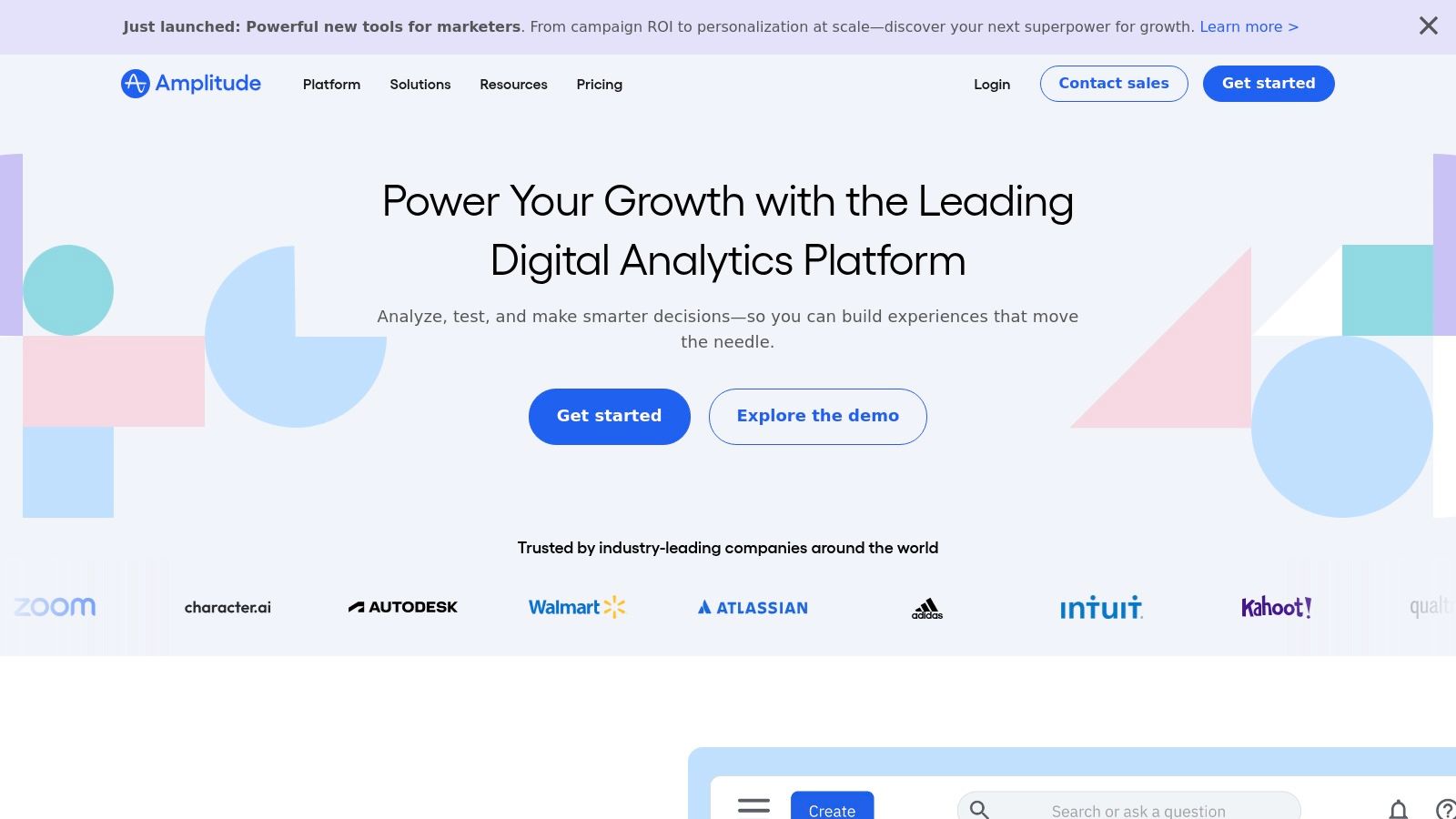
For example, imagine you're running a SaaS business with a freemium model. Amplitude can help you track how free users are interacting with specific features, identify the actions that lead to paid conversions, and ultimately optimize your onboarding process to improve your free-to-paid conversion rate. You can analyze which features drive the most engagement and then tailor your in-app messaging and prompts to nudge users towards those valuable actions.
Amplitude's strength lies in its advanced analytics capabilities. Its behavioral cohort analysis lets you compare the conversion patterns of different user groups, revealing what sets your most successful users apart. Funnel analysis allows you to pinpoint drop-off points within your conversion flows and identify areas for improvement. Retention and engagement tracking over time provides valuable insights into user lifetime value and helps you understand what keeps users coming back.
Key Features:
- Behavioral cohort analysis for conversion patterns: Segment users based on shared characteristics and analyze their conversion journeys.
- Advanced funnel analysis with conversion segmentation: Identify bottlenecks and optimize key conversion steps within your product.
- Retention and engagement tracking over time: Measure user stickiness and understand long-term engagement patterns.
- Predictive analytics for conversion optimization: Anticipate user behavior and proactively optimize the user experience.
- Cross-platform user journey mapping: Track users across different devices and platforms to get a holistic view of their interactions.
Pros:
- Powerful visualization of complex user journeys.
- Excellent for product-led growth measurement.
- Strong focus on user retention and lifetime value.
- Free starter plan with generous limits.
Cons:
- Primarily focused on product analytics rather than marketing campaigns. This means it might not be the best solution if your primary goal is tracking conversions from external marketing efforts like ads or email campaigns. Tools like Google Analytics might be more suitable for that purpose.
- Can require significant configuration for optimal insights.
- Enterprise pricing is considerable for advanced features.
- Learning curve steeper than some alternatives.
Pricing: Amplitude offers a free "Starter" plan, which is suitable for basic tracking and analysis. Paid plans offer more advanced features and higher usage limits, with pricing based on the number of monthly tracked users and the specific features you need. Contact Amplitude for detailed pricing information on their "Growth" and "Enterprise" plans.
Implementation Tips: While Amplitude does have a steeper learning curve compared to some simpler analytics tools, it offers extensive documentation and support resources to help you get started. Key to successful implementation is careful planning of the events you want to track, ensuring they align with your key conversion goals. Start with a few core events and gradually expand your tracking as you become more familiar with the platform.
Website: https://amplitude.com/
Amplitude earns its spot on this list due to its powerful product analytics capabilities and focus on user behavior within your digital product. If you are looking to understand what drives user engagement, optimize your conversion funnels, and improve user retention within your app or website, then Amplitude is a tool worth exploring. While it may not be the ideal solution for tracking marketing campaign conversions, its in-depth product analytics make it a valuable asset for businesses focused on product-led growth.
Top 10 Conversion Tracking Tools Comparison
| Tool | Core Features ✨ | User Experience ★ | Value Proposition 💰 | Target Audience 👥 | Unique Selling Points 🏆 |
|---|---|---|---|---|---|
| LeadPulse 🏆 | Full multi-channel attribution, CRM integrations, AI fallback (soon) | ★★★★☆ Easy setup, no coding | Free tier + flexible pricing | Marketers, SMBs, agencies | Effortless setup, accurate multi-page tracking, real-time CRM data |
| Google Analytics 4 | Event-based tracking, predictive analytics | ★★★☆☆ Complex but powerful | Free | All businesses, digital analysts | Strong Google Ads integration, AI insights |
| Meta Pixel | Conversion API, remarketing, dynamic ads | ★★★☆☆ Requires setup, technical | Free | Meta advertisers | Deep Meta platform integration |
| Adobe Analytics | Customer journey, predictive analytics, segmentation | ★★★☆☆ Enterprise-grade, complex | High cost | Large enterprises | Advanced customization, Adobe ecosystem integration |
| Mixpanel | User-centric funnels, cohort analysis, A/B testing | ★★★★☆ Intuitive UI | Free tier, can be costly | Product teams, mobile apps | Real-time funnel insights, product focus |
| HubSpot | End-to-end tracking, lead scoring, CRM integration | ★★★★☆ User-friendly, all-in-one | Free basic tier, premium costly | B2B companies, sales-driven teams | Marketing-sales alignment, closed-loop reporting |
| Segment | Data routing, identity resolution, event streaming | ★★★☆☆ Technical setup required | Medium to high | Developers, data teams | Centralized data delivery |
| Hotjar | Heatmaps, session recordings, surveys | ★★★☆☆ Easy, visual insights | Basic free, pricey at scale | UX teams, marketers | Qualitative insights complementing analytics |
| Heap | Autocapture, retroactive conversion definition | ★★★☆☆ Minimal setup, data-heavy | Free tier, enterprise cost | Product analysts, growth teams | No code event tracking, retroactive analysis |
| Amplitude | Cohort analysis, funnel segmentation, retention | ★★★★☆ Powerful product analytics | Free starter, tiered pricing | Subscription apps, product teams | Strong retention and engagement focus |
Choosing the Right Conversion Tracking Tool for Your Needs
Finding the right conversion tracking tools can feel overwhelming with so many options available. This list covers a range of tools, from comprehensive platforms like Google Analytics 4 and Adobe Analytics to more specialized solutions like Mixpanel, HubSpot, and Heap. Remember, the ideal tool for you depends on your unique business needs and technical comfort level. If you're a non-technical marketer primarily focused on lead generation through forms and integrating with your CRM, factors like ease of setup and seamless integration with your existing tools (like Webflow, Typeform, and HubSpot) are key considerations. Similarly, if you’re a small business owner, budget and the level of support offered by the tool vendor might be important deciding factors. For those focused on software development and optimizing lead capture from landing pages, building and deploying those pages efficiently often involves implementing a robust CI/CD pipeline. Essential CI/CD Pipeline Best Practices: A Complete Guide to Mastering Continuous Integration and Delivery from Mergify offers valuable insights in this area.
Ultimately, the most important takeaways are to clearly define your objectives, evaluate your existing marketing stack, and choose a conversion tracking tool that aligns with both. By taking the time to assess your specific needs and exploring the diverse options available, you'll be well-equipped to unlock valuable insights, optimize your campaigns, and drive substantial ROI. Ready to streamline your lead tracking and unlock hidden conversions? LeadPulse makes it easy to connect your forms and CRMs to attribute leads correctly—no coding required. Start your free trial today and discover where your leads really come from.